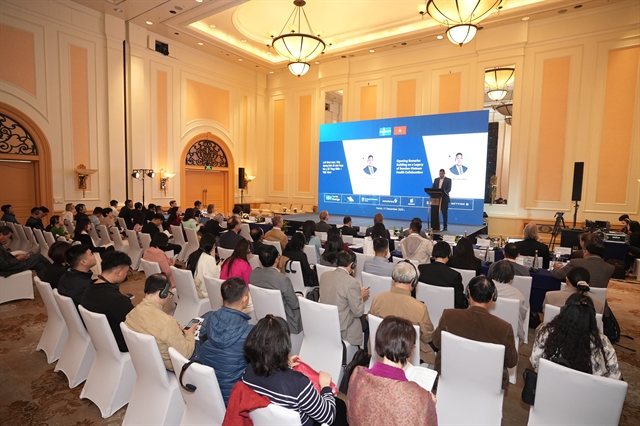 Economy
Economy

 |
| An electric vehicle charging station in Hà Nội. — Photo VietnamPlus.vn |
HÀ NỘI — Việt Nam’s auto market is entering a vibrant phase, as a surge in imported vehicles, electric cars and hybrids gathers momentum.
Intense competition between domestic and foreign manufacturers is reshaping the industry, ushering in a period of major transformation in both technology and consumer behaviour.
According to the latest figures from the Department of Customs, Việt Nam imported 16,343 cars in October. Although this represents a 5.5 per cent drop from the previous month, total imports over the first 10 months reached 171,364 units, up 20 per cent year on year. Import turnover neared US$4 billion, the highest level in the past three years.
Data from the Vietnam Automobile Manufacturers’ Association (VAMA) shows that its members sold 131,503 fully imported vehicles in this period, an increase of 17 per cent, while domestically assembled cars reached 119,918 units, up just 6 per cent. The widening gap underscores a clear shift in consumer preference towards imported models.
Dealerships report that Vietnamese buyers are increasingly favouring imported cars for their modern designs, advanced technology and consistent quality.
Japanese, South Korean, European and Chinese brands have simultaneously launched a variety of new SUV and crossover models to meet increasingly diverse demand.
Nguyễn Minh Tân, owner of a car dealership in Hà Nội, commented that imported cars are no longer a luxury item but a practical choice for those who demand quality and experience.
Models priced between VNĐ800 million ($30,400) and VNĐ1.5 billion ($57,000) are currently the key segment of the market, he said.
Meanwhile, electric vehicles (EVs) and hybrids are emerging as standout trends. VAMA reported sales of 9,798 'green' vehicles in the first 10 months, with hybrid sales soaring by 73 per cent year on year, a record that highlights growing demand for cleaner transport options.
VinFast continues to dominate the EV landscape, with sales of 103,884 electric cars, accounting for roughly 20 per cent of the national market. With 11 consecutive months at the top of the sales charts, the company has reinforced its position as Việt Nam’s leading EV manufacturer and a symbol of the country’s ambitions in the green automotive sector.
Aside from VinFast, a number of foreign brands like BYD, MG, Hyundai, Mercedes-Benz and Geely have entered the Vietnamese EV market with a bang.
Incentive policies like an exemption from registration fees for EVs, along with a growing 'green living' trend among urban youth, have provided a significant boost to this segment.
A representative from a Chinese car brand told the Vietnam News Agency that Vietnamese people, especially the younger generation, have changed their perception of electric cars. They see them as a trendy, cost-effective choice that reflects a modern, sustainable lifestyle.
Race for market share
Despite strong growth, competition between domestic and foreign brands is fiercer than ever. VinFast remains the leader in the EV segment, with over 60 per cent of the market share.
However, the rapid rise of foreign brands is narrowing the gap. BYD, Lynk & Co and MG have launched a series of new products targeting young customers and are expanding their dealerships in several provinces, creating significant pressure for local companies.
Toyota and Honda continue to maintain their positions by pushing hybrid models and offering price reductions to stimulate demand. Toyota Vietnam reported a 6 per cent increase in sales, while Hyundai still holds the lead in the traditional gasoline engine vehicle segment.
Phạm Quốc Huy, a representative from a Toyota dealership in Hà Nội, said despite market pressure, local dealers still hold the advantage in reliability, after-sales service and resale value. Hybrid cars help customers adapt more easily during this energy transition phase, he noted.
Foreign brands are intensifying their 'smart localisation' strategy to reduce costs and take advantage of tax incentives. Honda Vietnam has announced plans to assemble the CR-V e:HEV hybrid vehicle model in Phú Thọ starting next year.
At the same time, the Geleximco Group (Việt Nam) and Chery (China) have broken ground on the GEL-O&J automotive factory in Hưng Yên Province, with an annual production capacity of 120,000 vehicles.
This factory will become a hub for producing new energy vehicles for the Vietnamese and regional markets.
Beyond products, carmakers are racing to improve after-sales services and customer experience.
According to an October survey by Auto Insider Vietnam, 63 per cent of respondents preferred imported vehicles due to perceived quality, while 54 per cent were considering buying an EV or hybrid in the next two years. Some 48 per cent viewed warranty policies as a decisive factor. These figures reflect a shift in consumer mindset from prioritising low prices to valuing long-term quality and post-purchase support.
Experts predict that Việt Nam’s auto market is entering a period of comprehensive restructuring. Domestic firms benefit from a deep understanding of the local market and policies, while foreign manufacturers retain advantages in quality and scale.
Between 2025 and 2030, the market is forecast to grow by 6-8 per cent annually, with electric and hybrid vehicles expected to account for 40-45 per cent of total sales by 2030. Foreign brands are likely to continue expanding investment, while domestic firms push ahead in developing supply chains for components, batteries and charging infrastructure. — VNS




